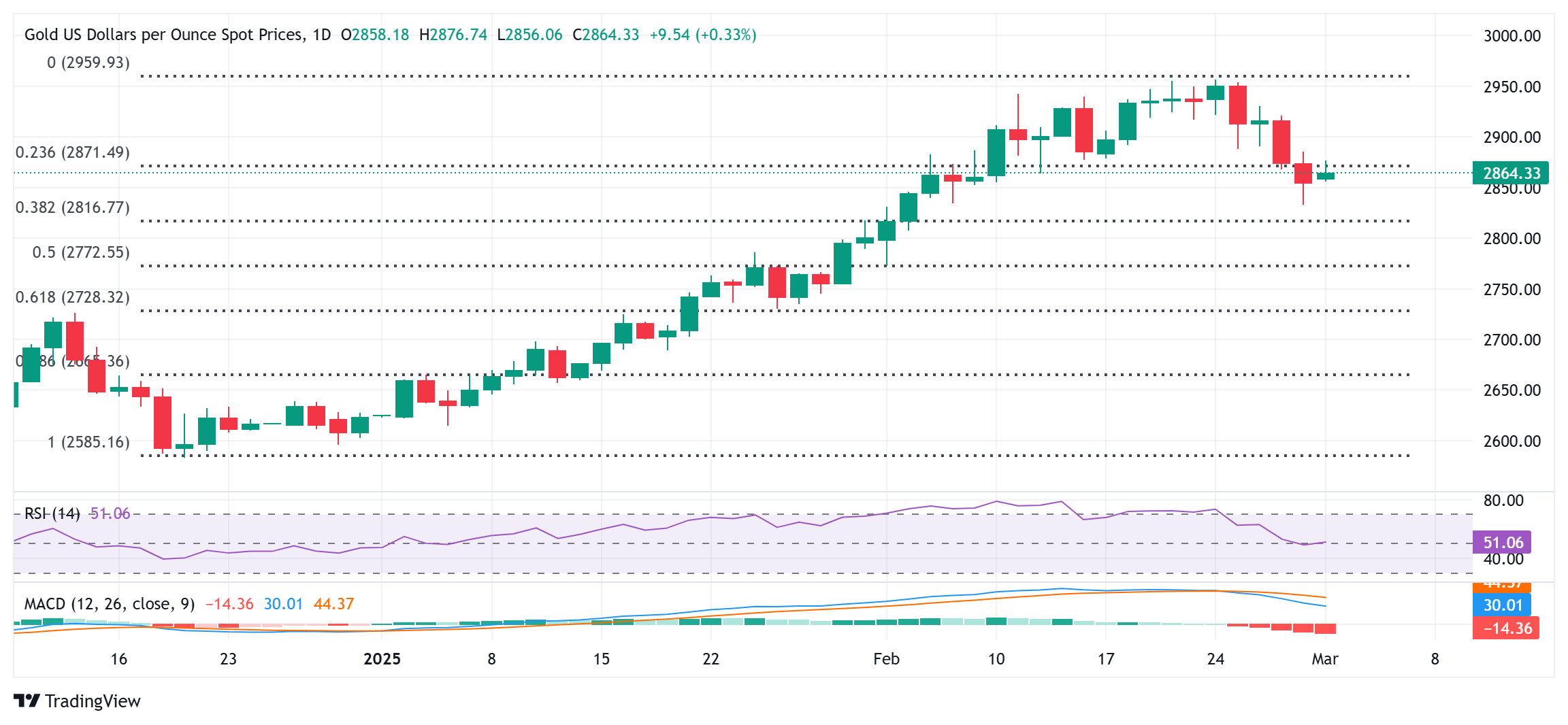- Gold price gained some positive traction on Monday amid modest US Dollar weakness.
- Bets that the Fed will cut rates again undermine the USD and benefit the XAU/USD pair.
- Concerns about Trump’s tariff plans and a global trade war also support the commodity.
Gold price (XAU/USD) struggles to build on its modest intraday gains through the early European session on Monday, though it manages to hold its neck above a three-week low touched on Friday. Traders are pricing in the possibility that the Federal Reserve (Fed) will cut interest rates by a quarter of a percentage point twice by the end of this year amid signs of deteriorating consumer sentiment. This, in turn, fails to assist the US Dollar (USD) to capitalize on a three-day-old recovery from over a two-month low touched last week and helps revive demand for the non-yielding yellow metal.
Apart from this, growing market worries about the potential economic fallout from US President Donald Trump's trade tariffs and geopolitical risks turn out to be other factors that benefit the safe-haven Gold price. That said, a generally positive tone around the equity markets keeps a lid on any further appreciating move for the bullion. Traders also seem reluctant and opt to wait for this week's important US macro releases before placing fresh directional bets. This, in turn, warrants some caution before confirming that the corrective pullback from the all-time high has run its course.
Daily Digest Market Movers: Gold price remain supported by trade war fears, weaker USD
- The US Bureau of Economic Analysis reported on Friday that the Personal Consumption Expenditures (PCE) Price Index rose 0.3% in January and increased 2.5% over the past twelve months, down slightly from 2.6% in December.
- Adding to this, the core PCE Price Index, which excludes volatile food and energy prices, gained 0.3% last month and climbed 2.6% on a yearly basis in January, marking a notable deceleration from 2.9% in the previous month.
- The report further revealed that US consumer spending unexpectedly dropped 0.2% last month, marking the first decline since March 2023 and the biggest decrease in nearly four years, fueling worries about the US growth outlook.
- According to the CME Group's FedWatch Tool, market participants are pricing in the possibility that the Federal Reserve will resume cutting interest rates at the June policy meeting and lower borrowing costs again in September.
- This comes on top of worries that US President Donald Trump's trade tariffs would undermine consumer spending and fail to assist the US Dollar to capitalize on a three-day-old recovery move from over a two-month low.
- Trump confirmed that he will impose tariffs on Canada and Mexico starting Tuesday and announced plans to double the 10% universal tariff on imports from China, raising the risk of a global trade war and benefiting the safe-haven Gold price.
- Traders now look to the US ISM Manufacturing PMI for some impetus later this Monday. Apart from this, other key US macro releases, including the Nonfarm Payrolls report on Friday, should influence the near-term USD trajectory.
Gold price bears have the upper hand; 23.6% Fibo. level support breakdown in play
From a technical perspective, last week's breakdown below the 23.6% Fibonacci retracement level of the December-February rally was seen as a key trigger for sellers. Moreover, oscillators on the daily chart have just started gaining negative traction, and back prospects for an extension of the corrective pullback from the all-time peak.
Hence, any subsequent move up might still be seen as a selling opportunity and remain capped near the $2,885 region. This is closely followed by the $2,900 mark, above which the Gold price could climb to the $2,934 intermediate hurdle en route to the record high, around the $2,956 region.
On the flip side, Friday's swing low, around the $2,833-2,832 zone, now seems to protect the immediate downside, below which the Gold price could fall to 38.2% Fibo. level, around the $2,815-2,810 region. Some follow-through selling below the $2,800 mark would suggest that the commodity has topped out and could pave the way for deeper losses.
Economic Indicator
ISM Manufacturing PMI
The Institute for Supply Management (ISM) Manufacturing Purchasing Managers Index (PMI), released on a monthly basis, is a leading indicator gauging business activity in the US manufacturing sector. The indicator is obtained from a survey of manufacturing supply executives based on information they have collected within their respective organizations. Survey responses reflect the change, if any, in the current month compared to the previous month. A reading above 50 indicates that the manufacturing economy is generally expanding, a bullish sign for the US Dollar (USD). A reading below 50 signals that factory activity is generally declining, which is seen as bearish for USD.
Read more.Next release: Mon Mar 03, 2025 15:00
Frequency: Monthly
Consensus: 50.8
Previous: 50.9
Source: Institute for Supply Management
The Institute for Supply Management’s (ISM) Manufacturing Purchasing Managers Index (PMI) provides a reliable outlook on the state of the US manufacturing sector. A reading above 50 suggests that the business activity expanded during the survey period and vice versa. PMIs are considered to be leading indicators and could signal a shift in the economic cycle. Stronger-than-expected prints usually have a positive impact on the USD. In addition to the headline PMI, the Employment Index and the Prices Paid Index numbers are watched closely as they shine a light on the labour market and inflation.
Information on these pages contains forward-looking statements that involve risks and uncertainties. Markets and instruments profiled on this page are for informational purposes only and should not in any way come across as a recommendation to buy or sell in these assets. You should do your own thorough research before making any investment decisions. FXStreet does not in any way guarantee that this information is free from mistakes, errors, or material misstatements. It also does not guarantee that this information is of a timely nature. Investing in Open Markets involves a great deal of risk, including the loss of all or a portion of your investment, as well as emotional distress. All risks, losses and costs associated with investing, including total loss of principal, are your responsibility. The views and opinions expressed in this article are those of the authors and do not necessarily reflect the official policy or position of FXStreet nor its advertisers. The author will not be held responsible for information that is found at the end of links posted on this page.
If not otherwise explicitly mentioned in the body of the article, at the time of writing, the author has no position in any stock mentioned in this article and no business relationship with any company mentioned. The author has not received compensation for writing this article, other than from FXStreet.
FXStreet and the author do not provide personalized recommendations. The author makes no representations as to the accuracy, completeness, or suitability of this information. FXStreet and the author will not be liable for any errors, omissions or any losses, injuries or damages arising from this information and its display or use. Errors and omissions excepted.
The author and FXStreet are not registered investment advisors and nothing in this article is intended to be investment advice.
Recommended content
Editors’ Picks

EUR/USD regains traction above 1.1000 ahead of US CPI release
EUR/USD has found fresh buyers and jumps above 1.1000 in the European session on Thursday. The pair gains on the German coalition deal and Trump's 90-day pause on reciprocal tariffs, which have lifted risk senitment while exacerbating the US Dollar pain ahead of the US CPI data release.

GBP/USD trades firm above 1.2850, US CPI data awaited
GBP/USD sustains the rebound above 1.2850 in European trading hours on Thursday. The British Pound capitalizes on risk appetite, courtesy of Trump's tariff pause, allowing the pair to recover ground. But further upside hinges on the US CPI data and US-Sino trade updates.

Gold price eases from weekly top amid risk-on mood; still well bid above $3,100 ahead of US CPI
Gold price trims a part of its strong intraday gains to a one-week high touched during the early European session on Thursday and currently trades just above the $3,100 mark. Concerns about escalating US-China trade tensions, along with fears about a tariffs-driven economic slowdown, turn out to be key factors that continue to underpin the safe-haven bullion.

US CPI data set to reveal March inflation dip as markets weigh impact of Trump’s tariffs
As measured by the CPI, inflation in the US is set to rise at an annual pace of 2.6% in March, down slightly from the 2.8% reported in February. Core CPI inflation, which excludes the volatile food and energy categories, is expected to ease to 3% in the same period from a year earlier

Trump’s tariff pause sparks rally – What comes next?
Markets staged a dramatic reversal Wednesday, led by a 12% surge in the Nasdaq and strong gains across major indices, following President Trump’s unexpected decision to pause tariff escalation for non-retaliating trade partners.

The Best brokers to trade EUR/USD
SPONSORED Discover the top brokers for trading EUR/USD in 2025. Our list features brokers with competitive spreads, fast execution, and powerful platforms. Whether you're a beginner or an expert, find the right partner to navigate the dynamic Forex market.




